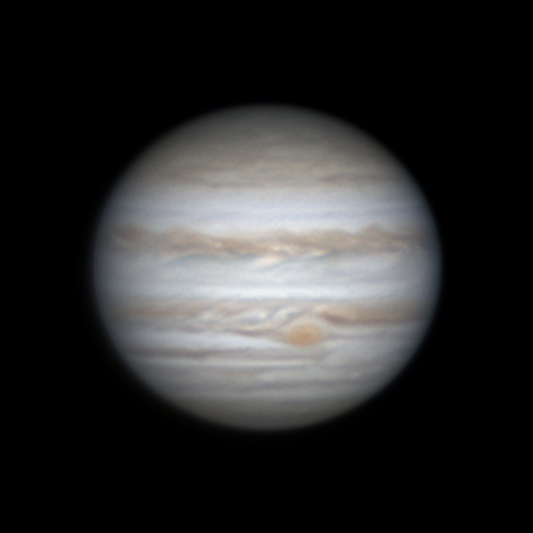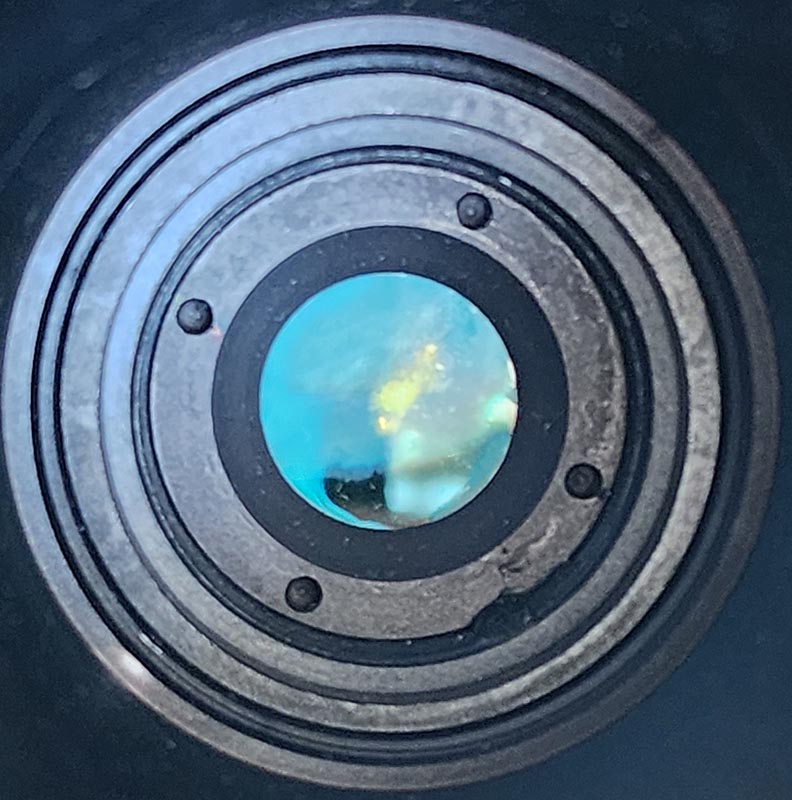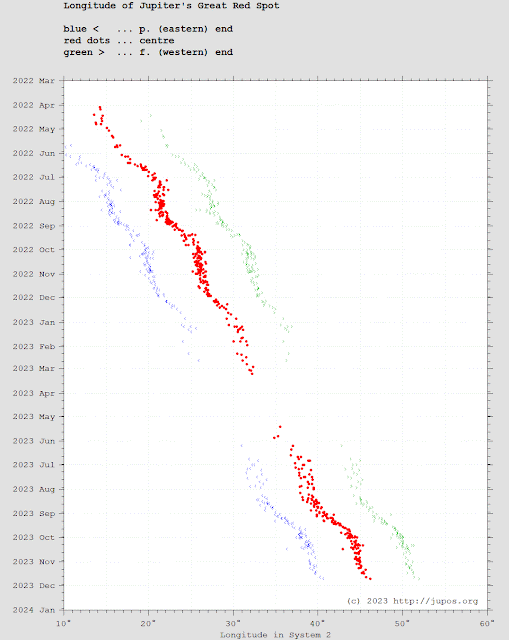Jupiter is the fastest rotating planet in our solar system, with a day lasting only 10 hours. thus Jupiter's Great Red Spot (aka small salmon spot) is only visible for a few hours each day. so if you see it one night, it will be visible 4 hours earlier or 6 hours later the next (multiples of 10 mod 24). this makes it tough to catch night over night. it's visible for about 2 hours and can be followed rotating across the face of the planet during that time.
 |
Jupiter
11/22/23 05:22 UTC
2023-11-22-0522_5
CM1 60.8, CM2 59.9, CM3 102.6 |
I recently noticed my planetarium software wasn't getting the position of the great red spot quite right. so off to the rabbit hole of jovian navigation...the short version is that clouds in jupiter's atmosphere do not rotate a constant rate. a planetary frame of reference was created, roughly defined by the position of the great red spot. however, the great red spot's rate of movement across the surface varies with time, so it's position has to be intermittently updated relative to the planetary reference system.
the following is largely verbatim from references listed below:
Because Jupiter is not a solid body, its upper atmosphere undergoes differential rotation. The rotation of Jupiter's polar atmosphere is about 5 minutes longer than that of the equatorial atmosphere (wikipedia).
Three systems are used as frames of reference for tracking planetary rotation, particularly when graphing the motion of atmospheric features. System I applies to latitudes from 7° N to 7° S; its period is the planet's shortest, at 9h 50 m 30.0s. System II applies at latitudes north and south of these; its period is 9h 55 m 40.6s. System III was defined by radio astronomers and corresponds to the rotation of the planet's magnetosphere; its period 9 h 55 m 29.710s is Jupiter's official rotation (GJI).
"most (but not all) higher-latitude atmospheric disturbances including the Great Red Spot and the three white ovals move only slowly in system II." (GJI)
the Red Spot was at Jovian System II longitude 46° in November 2023 and continues to drift 1.75° per month, based on historical trends noted by JUPOS (sky and telescope)
note the planetary image above is annotated with 3 different central meridian (CM) positions, one for each system.
historical trends and recent observations are listed at JUPOS the organization associated with winjupos, a sophisticated planetary mapping program designed for advanced amateur astronomers to track planetary features. ironically the GRS position in the winjupos planetary surface texture is way off.
in the image above and my 11/12/2023 06:45.8 UTC image, i measured the GRS longitude at 46 in winjupos. sky safari lists it at 50, accounting for the difference in the image and planetarium software.
references:
https://en.wikipedia.org/wiki/Jupiter
On the rotation of Jupiter
R. Hide
Geophysical Journal International, Volume 64, Issue 1, January 1981, Pages 283–289,
https://doi.org/10.1111/j.1365-246X.1981.tb02668.x
https://skyandtelescope.org/observing/interactive-sky-watching-tools/transit-times-of-jupiters-great-red-spot/
historical trends and recent observations JUPOS.org:
http://jupos.privat.t-online.de/
imaging details:
eastbluff, CA
11/22/23 05:22 UTC
CM1 60.8, CM2 59.9, CM3 102.6
celestron 11" Edge HD
baader IR/UV block filter
ZWO ADC
ZWO ASI 290MC (one shot color camera)
11x90 second captures 05:15-05:30 UTC
FPS (avg.)=27-110
Shutter=5.545ms
Gain=351 (58%)
Histogramm=85%
downsampled to 66 % :(
software:
firecapture
autostakkert
winjupos
registax
photoshop




































